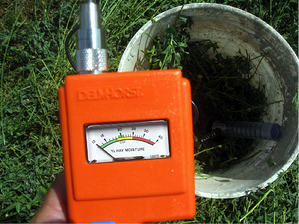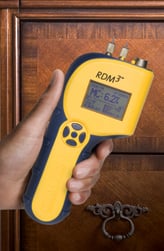As a tool for farming, working with wood, checking the progress of a building restoration job, or for monitoring the relative humidity in a concrete slab, moisture meters are incredibly useful. These handy devices come in many different shapes, sizes, and even have different operating methods and types of displays.
For some professionals, having the right type of display on a meter is just as important as the meter having the ability to use different probe types or being calibrated to the right type of material for their work. With this in mind, we wanted to take some time to talk about analog and digital moisture meter displays.
About Analog Displays
 An analog display uses a panel meter that includes a needle set in front of a marked dial to show the user the moisture reading the meter is taking. This display type was the standard for many years, and still remains popular among experienced professionals to this day.
An analog display uses a panel meter that includes a needle set in front of a marked dial to show the user the moisture reading the meter is taking. This display type was the standard for many years, and still remains popular among experienced professionals to this day.
Advantages of an analog display include:
-
Ease of use. Meters that use analog displays are built with simplicity in mind. There aren’t usually as many extra functions to learn with an analog display meter as there would be with a digital display meter.
-
Yes or no moisture indication. When calibrated for a specific task, these meters can be a fast way to see if the moisture content for the object being tested is too high, too low, or just right using a color-coded display card.
While appreciated most by experienced users, the simplicity and ruggedness offered by analog meters makes them great for new users as well. However, analog displays aren’t without their drawbacks.
The biggest issue with using an analog display is that getting a decimal point-precise reading is very difficult. When the needle falls somewhere between 12% and 13%, what is the exact reading supposed to be? In most applications, you probably won’t need that level of precision in readings, but for some professionals, having the exact decimal point of the reading on record is important for documentation purposes.
The second disadvantage to analog displays is durability. The meter movement is the most delicate component of the display, and even if a high-qualty panel meter is used, it is susceptible to damage to the extent that the needle may become stuck.
About Digital Displays
 Moisture meters with digital displays are the new standard for professionals around the world. These meters have an LCD or other type of electronic display that provides clear-cut numerical readings.
Moisture meters with digital displays are the new standard for professionals around the world. These meters have an LCD or other type of electronic display that provides clear-cut numerical readings.
Why are so many professionals using digital displays instead of analog ones these days? Here are a few of the advantages of digital displays that might explain why:
-
Digital Displays are Easy to Read. With a digital display, you’re getting a hard fast number on a screen. This removes any guesswork from the task of taking down moisture readings. With a digital display, there’s no ambiguity about whether the reading is 12.1% or 12.2% because the number’s right there on the screen.
-
Extra Display Functionalities. With a digital display, it is easier for a moisture meter manufacturer to add more functions to a single device. For example, with a digital display, it’s possible to show both the current moisture reading and an average of your last 100 readings. Displaying both at once allows the user to compare the current moisture reading against the average directly, making it easier to spot an anomalous result.
-
Durability. Because a digital display contains no moving parts, it is more rugged than an analog meter. Although even the most rugged moisture meter may be damaged when dropped, one with a digital display is much more likely to withstand the toughest work environment.
With a digital display, the functionality of the meter’s display is much less limited than with an analog one. This allows meters with a digital display to be designed with a greater range of features than one with an analog display, as the digital display can be altered to match the function being used, as opposed to being stuck with a single needle indicator superimposed over a card.
Which Meter Display Type is better?
In most situations, the digital display is probably going to be the best type to use. The additional cost to purchase a digital moisture meter often outweighs the cost to repair an analog moisture meter that requires the replacement of the analog panel meter.
With a digital meter display, moisture meters can be programmed for a wider variety of tasks and you can get readings in different scales if the meter is programmed for it. With an analog display, what you see on the card is all you get.
However, there are many people who prefer analog displays, and use them to great effect in their work. This is part of the reason why Delmhorst remains dedicated to stocking both digital and analog display meters.
Find the right moisture meter for your work today!

Comments